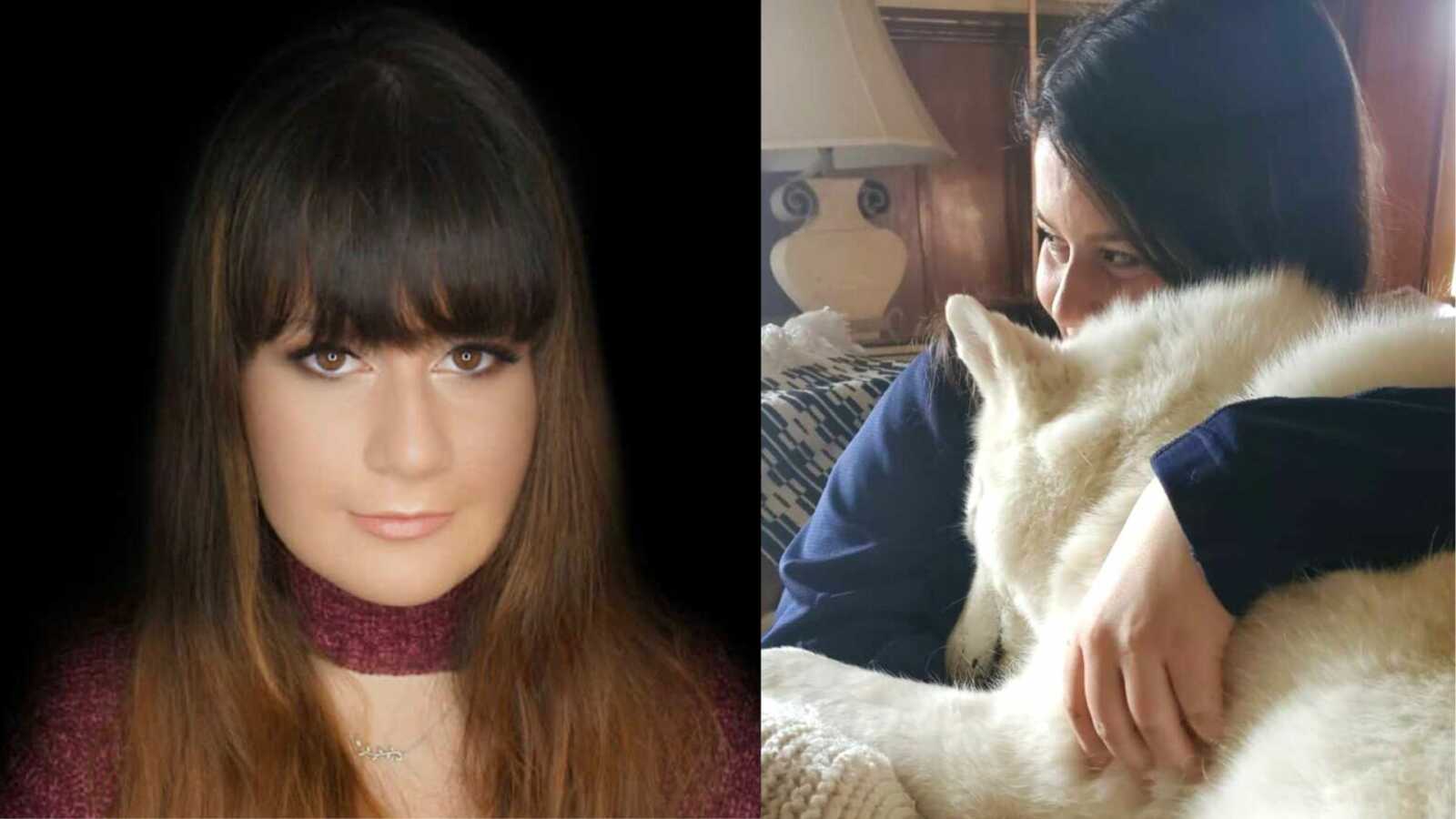Disclaimer: This story contains details of anorexia and medical trauma which may be upsetting for some.
Childhood
“When I fantasized about being a writer as a child, writer being one of the earliest budding parts of my identity, the vision tiny Leah had of sophisticated, grown up Leah working on a writing project was a far cry from the reality of the electric, ambulatory wheelchair I’m perched in, clutching belly-soothing tea as I write this. You see, I was raised as a happy, giggly, able-bodied little girl with a passion for everything I tried – singing, songwriting, dance, yoga, nature. I’ve always LOVED good food (the food thing is key), and was constantly called a ‘little foodie’ for my sophisticated taste buds by my parents’ friends. I was just a kid who loved experiencing life. I met every morning with puppy-like excitement; it’s almost comical how idyllic and firefly-speckled my childhood was. Think enchanted forest meets all the best parts of the late nineties and early two thousands. I was a horseback riding, ice skating, rock collecting nine-year-old, turned competitive marathoning pre teen with a passion for music and even a lucky little start in the music world.
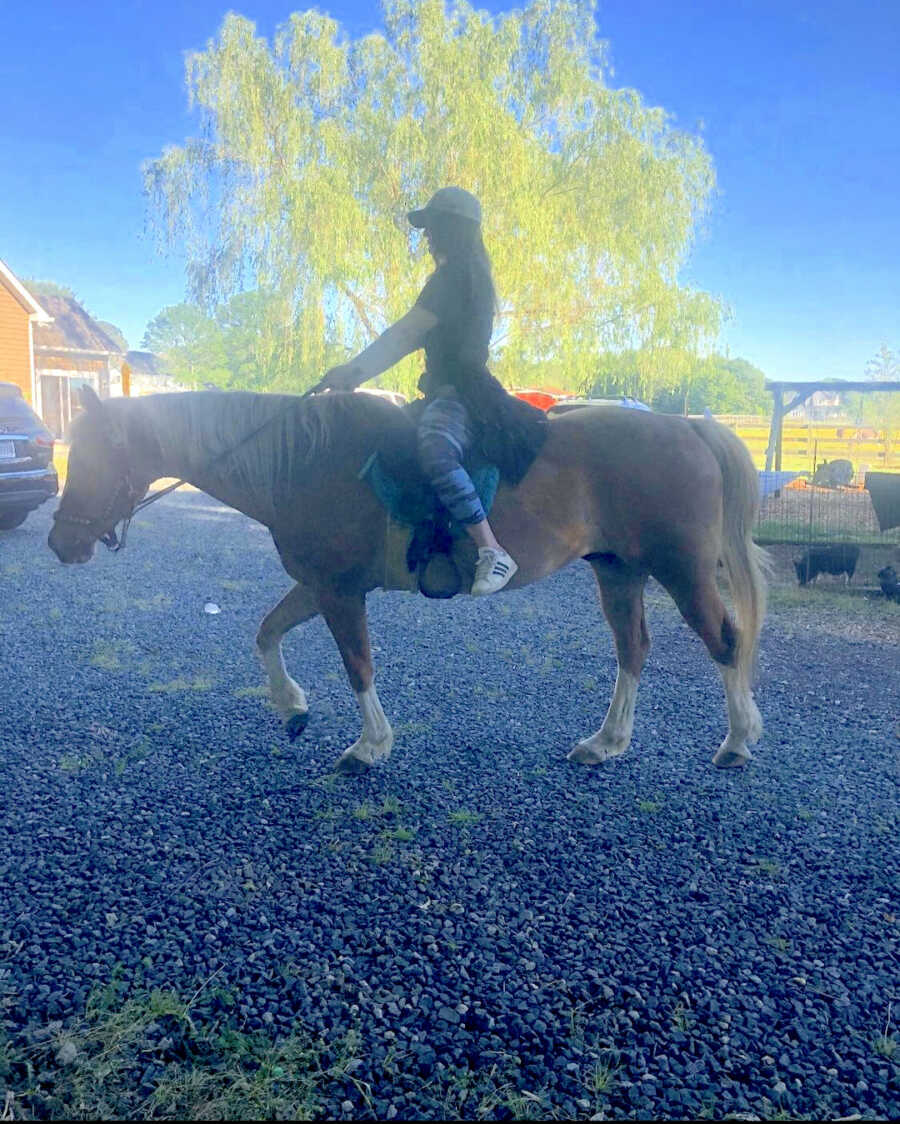
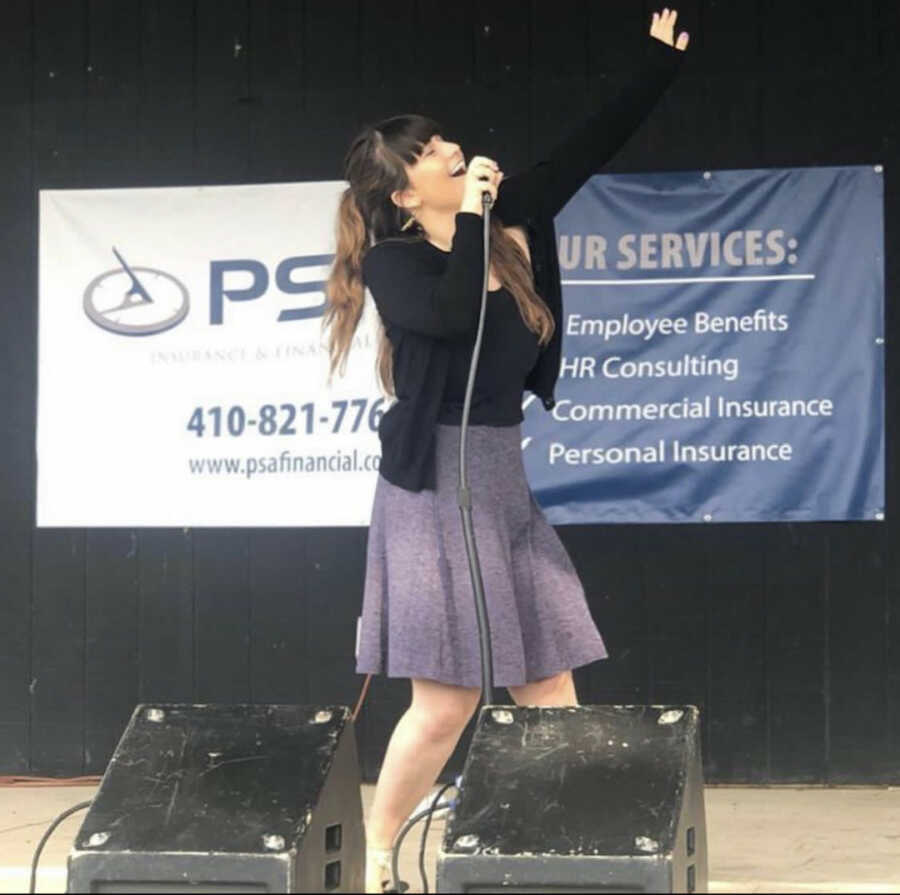
Never did I imagine the next two phases of my life would be rageful, traumatized, gaslit, confused, disabled teenager and then joyful, slightly messy, but wildly happy disabled adult. I dreamed of floor to ceiling, deeply ADA inaccessible apartments in bustling cities, the future images of myself tinged with a collage of influences: Carrie Bradshaw-esque stilettos as I mastered my crafts, following my passions without anything to hold me back, Taylor Swift bangs, and of course, a Grammy and a New York Times Best Seller humble-bragging in my home office by the age of 30. If achieving bestie status and co-hosting SNL with Amy Schumer was a high reach, I figured I’d at least have legs that committed to working every day. But alas, life is so beautifully weird.
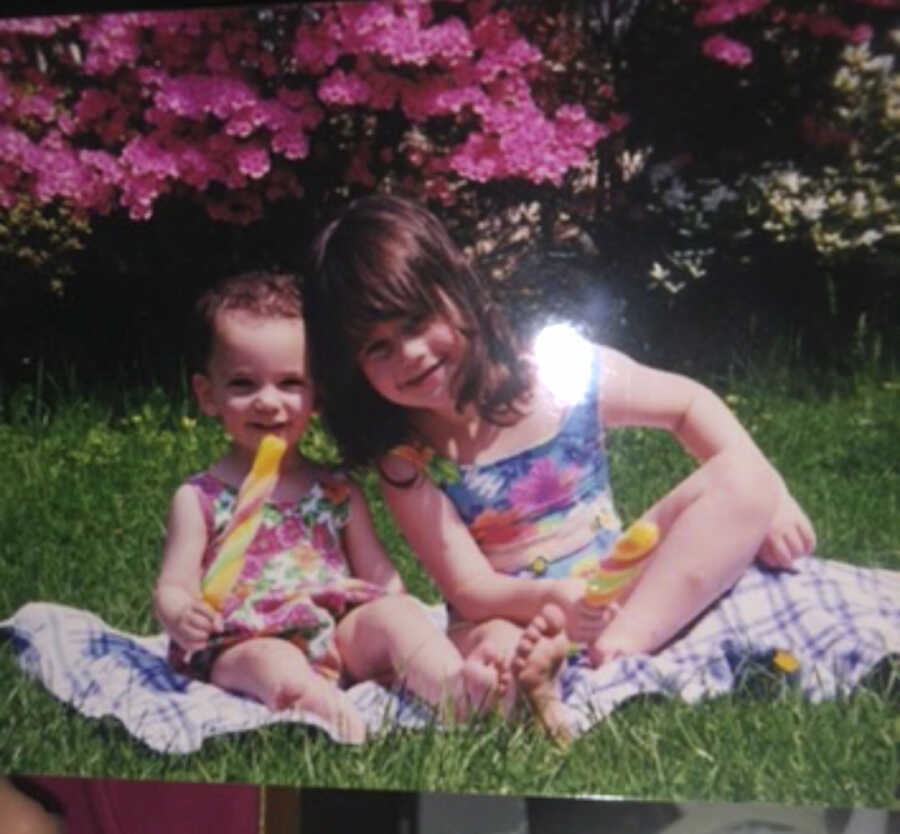
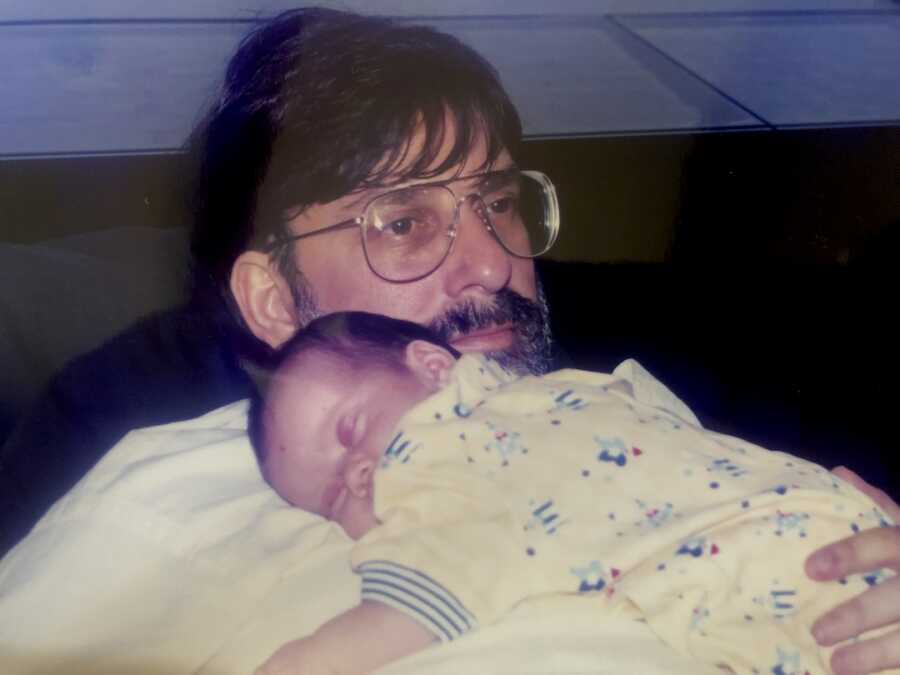
Beginning Symptoms
At the age of fifteen, I noticed the clock was getting hard to see, especially when I came home from marathon training. I did what any other able-bodied teen in that point in time would do – ignored it and watched the Kardashians. As I continued through school, I began to ignore the signs even harder, as the back of my mind noticed my pain levels were changing, and I didn’t want to explore that particular road, so I chose denial. I had midterms and friendships and boys and important things that needed my attention; my blurry vision and painful joints didn’t fit in the picture and needed to be avoided at all costs. But gym recoveries didn’t feel quite right anymore, like my muscles weren’t healing quite right from each workout. I was constantly dizzy, even fainting post-workout several times a week. When I called my doctors with these symptoms, I was frequently told they were just common in women my age and to wait it out.
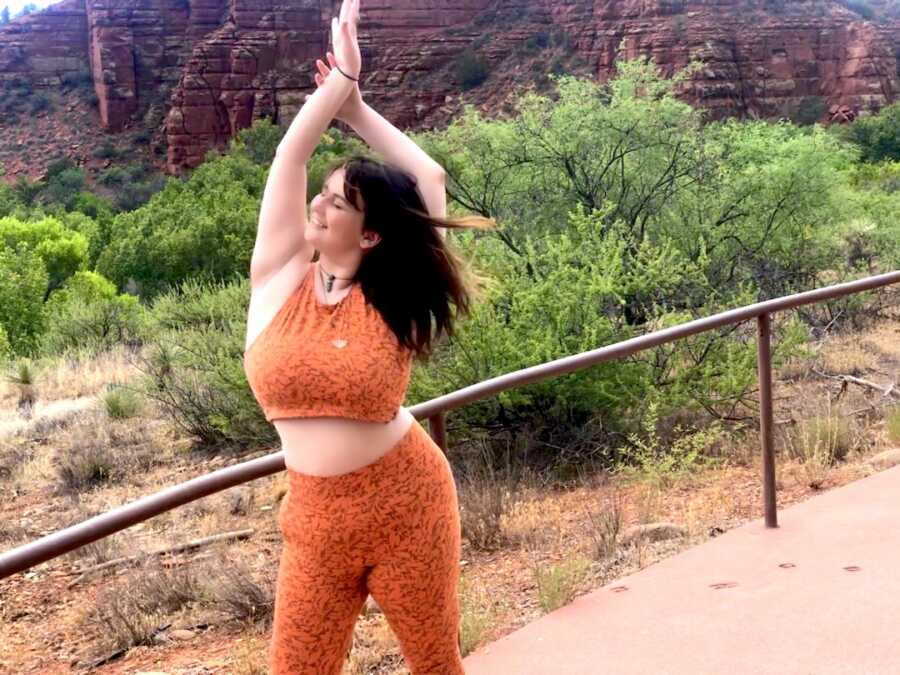
I figured I had just ‘leveled up,’ and was feeling more pain, like diet culture had told me I was SUPPOSED to feel. I stopped feeling hungry, or nourished, or being able to really digest food very well at all. I tallied it up to needing to ‘clean up my diet,’ and carried on (we later discovered this to be celiac disease). However, the thing about bodies, particularly chronically ill ones, is if they have a message for you, they will not give you the option of missing that message. It doesn’t matter how many trendy fad diets you throw at it, how hard you close your eyes, how loud you try to sing over the noise, when your body needs your attention it will grab it from you by any means necessary. I learned this the aggressive way.
Misdiagnosis & Harmful Misleading
Finally, the denial question was taken out of my hands as my parents awoke to the melodious ‘thunk,’ of their youngest daughters’ chin splitting open against the tile of their bathroom floor. They took me to my primary care physician who looked me up and down once, took my blood pressure, and said (trigger warning: doctors encouraging pro-Anorexia behaviors,) verbatim, ‘Oh, she has POTS syndrome. We like to call it cheerleaders disorder because all of the thin young women get it. Just make sure to eat well, and keep your weight down where it is, and you’ll be just fine.’
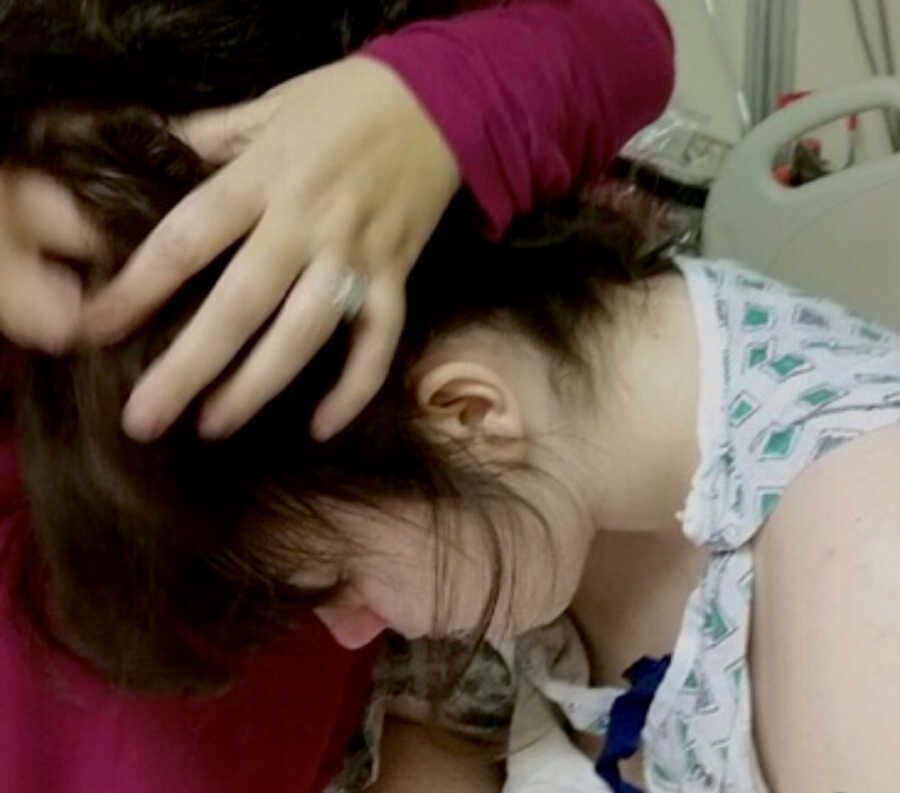
He then proceeded to put me on my first ever round of steroid treatment without a singular warning as to how this might affect the comment he had literally just made about avoiding weight gain, but more on that nonsense later. In that one appointment I was told my ‘thin’ body (who’s shape I’d genuinely had yet to notice at that point, as aforementioned: unrealistically happy childhood,) was both the cause for my pain, but would also be the cause of my demise should I let it deviate from the thinness the doctor directly told my sponge-like teenage brain was causing my POTs syndrome AND keeping me safe from it (it wasn’t doing either, for the record- my weight was irrelevant).
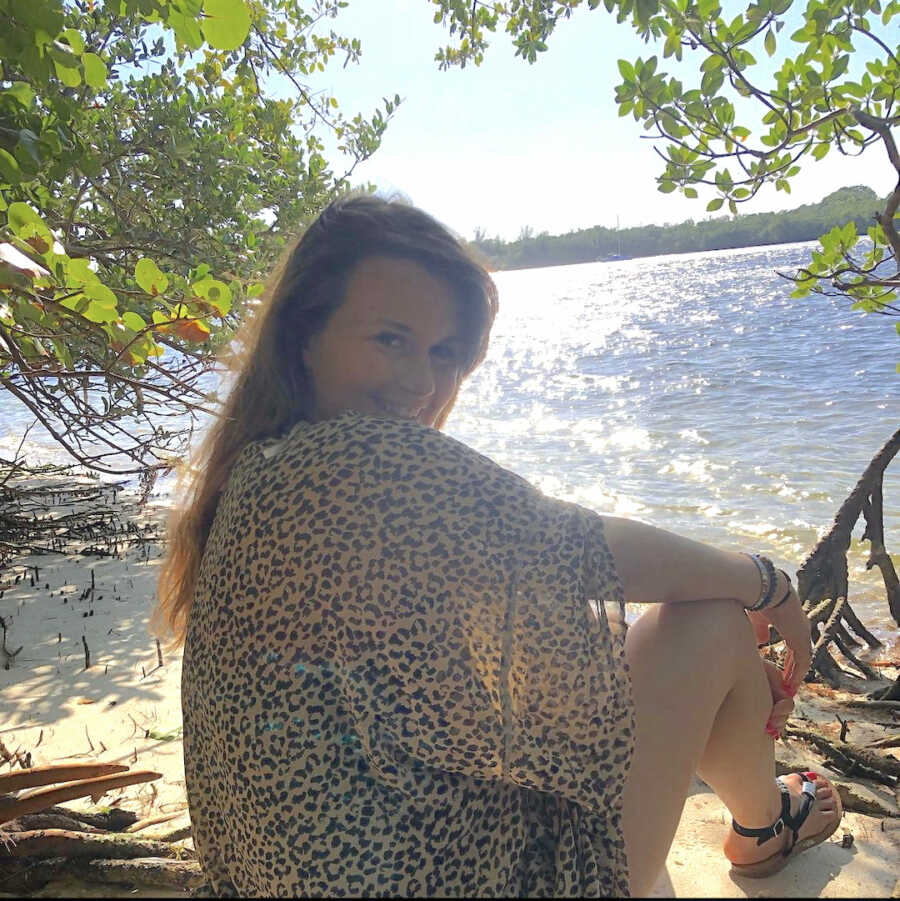
No matter how many times I tried to ask what on earth he meant by my thinness being both the problem and the solution, it was laughed off. I was essentially told my immense pain and fear could all be exercised away, that the bad blood work could be changed if I ate a perfect 1200 calories a day or less of influencer-approved superfoods. These doctors had me convinced that if I pushed through my body’s signals to ‘please, please STOP,’ and could continue their rigorous versions of diet and exercise while pretending to be an able-bodied person, maybe I’d stay one. Maybe if I ran away from the disability hard enough, I could actually outrun my genetics by staying fit enough to avoid the illnesses that were not actually genetically avoidable for me. A lupus doctor once told me I would, ‘Heal faster if I put the cake down.’ I hadn’t eaten in three days. Sufficient to say, I ended up with an exercise addiction, that I’m 621 days clean from as of this sentence I’m typing right now. I leaned into diet culture. Hard. Every influencer with a claim to anecdotal dietary restrictions that helped their chronic pain became a leader to me, absolutely shredding my organic relationship with food.

I spent about a year and a half thinking POTs syndrome (an acronym for Postural orthostatic tachycardia syndrome) was the reason for all of my symptoms. Eventually though, my symptoms became too broad for just POTs to be causing them. It sounds dramatic, but I genuinely woke up one morning to my vision being nearly gone overnight (we later learned this was due to inflammation near my optic nerve). My joints had had a sensation for a while now, of slowly collapsing from under me, causing extreme pain and stiffness.
Support System
I went back to the doctor, confused and heartbroken as to how I could’ve gone so far to follow his rules that I’d ruined my joy of food in committing my life to them, but gotten sicker anyway. I don’t say committing my life lightly, I was trying to manage my healing full time. I was so sick I had to drop out of twelfth grade just to keep up with trying to seek answers full time. My parents were warriors in advocacy, my siblings were well intentioned and confused at first, but then the fiercest support system ever.
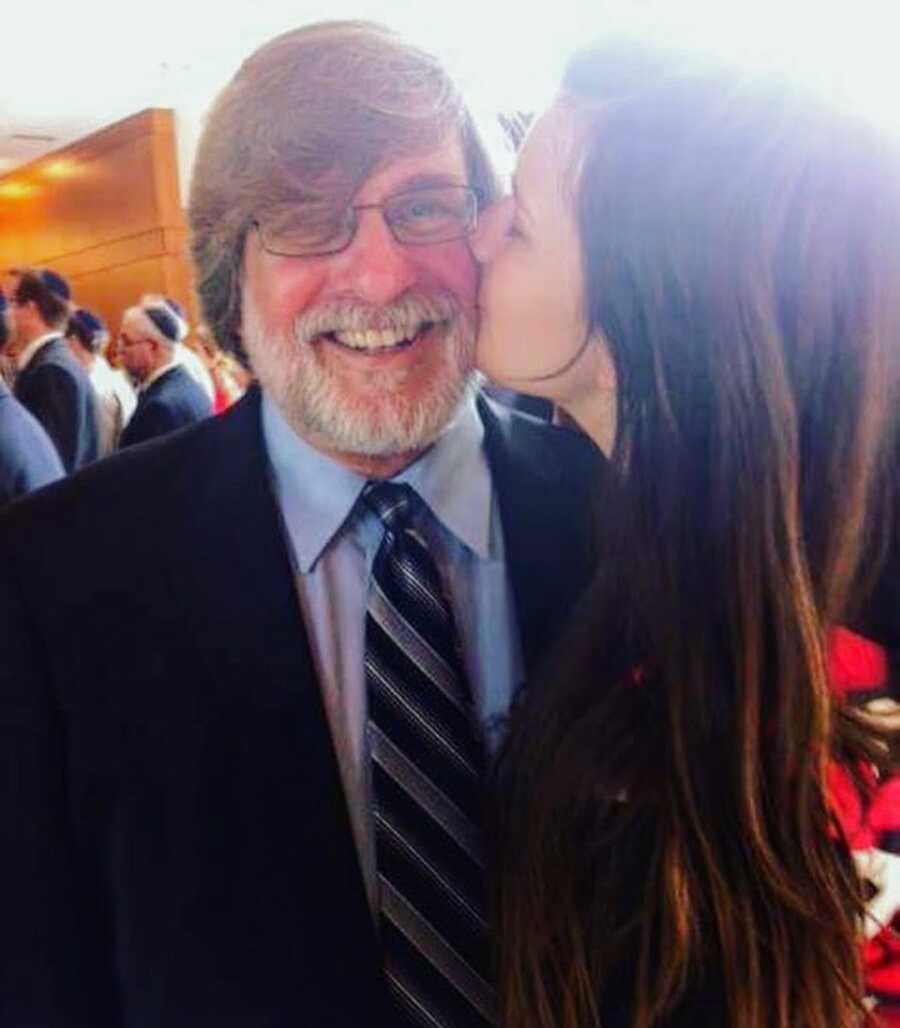
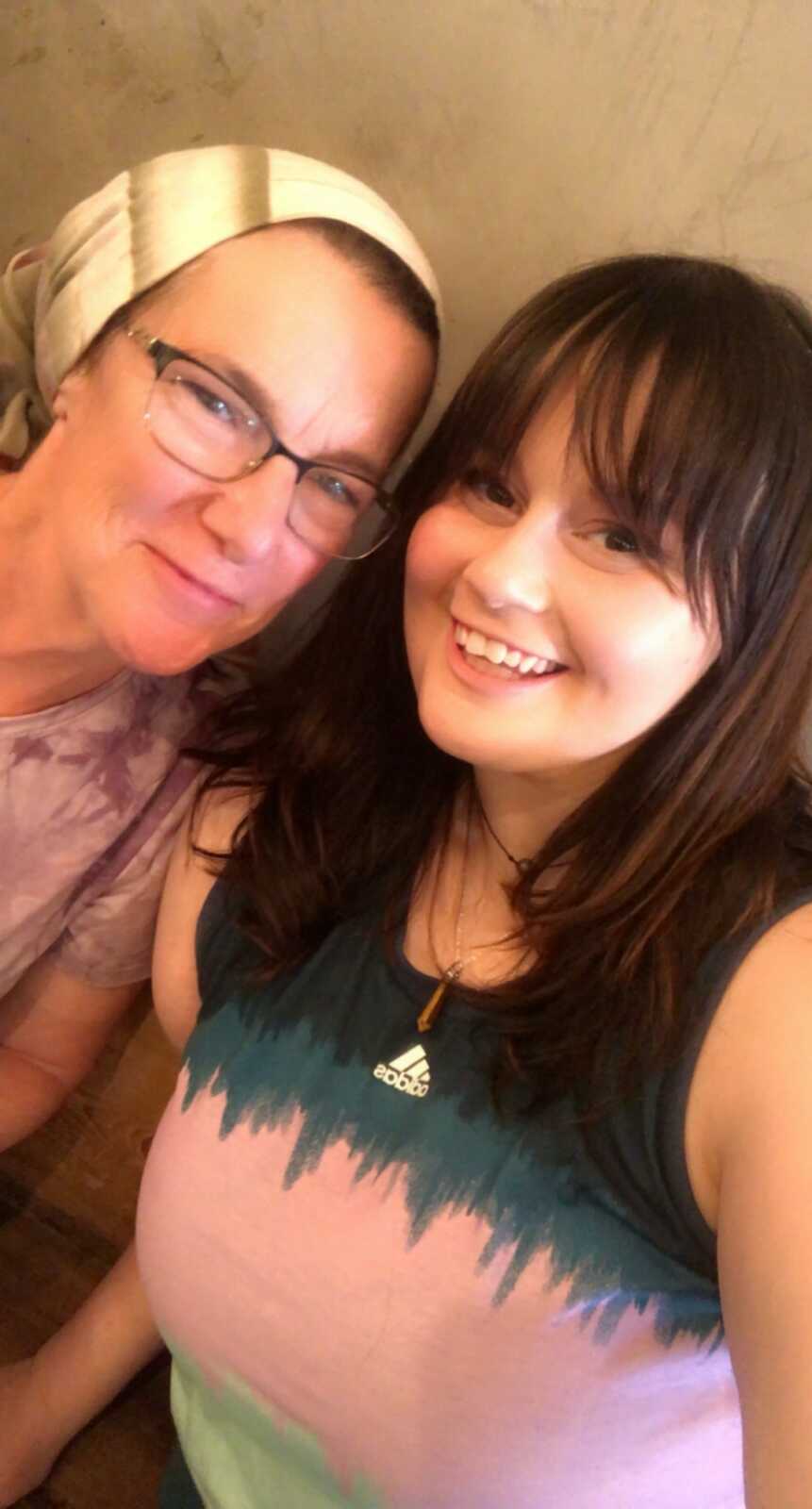
As for my friends…I am grateful for who’s stayed. I sort of always knew who truly would for the most part. The friends who fall asleep in your hospital beds with you always have a special space in your soul. The love I felt for the twelfth-grade girls who stayed my best friends while I became a disabled teenager is immeasurable and always will be. But becoming visibly disabled also really brought out the true colors of a lot of people I thought I was truly close with. At the end of the day, I am sad and grateful to have lost those friends. Those who aren’t willing to adjust to your pace or who make your illness about themselves are genuinely exhausting.

Romantically, my partner is my actual partner in every aspect of being ill and I don’t know how I ever did it without him. I became the most disabled I’ve ever been just as we started dating and he made me feel like a goddess as I transitioned to being unable to walk alone and get in my wheelchair for the first time (last year).
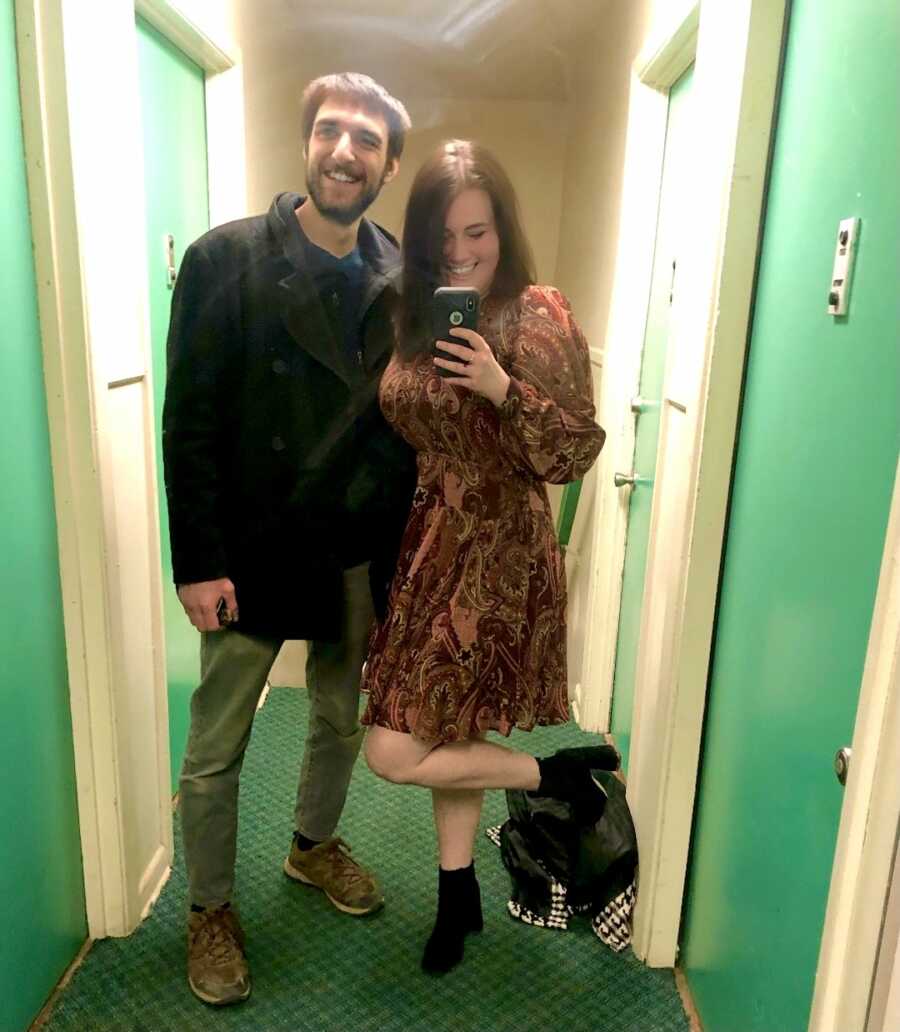
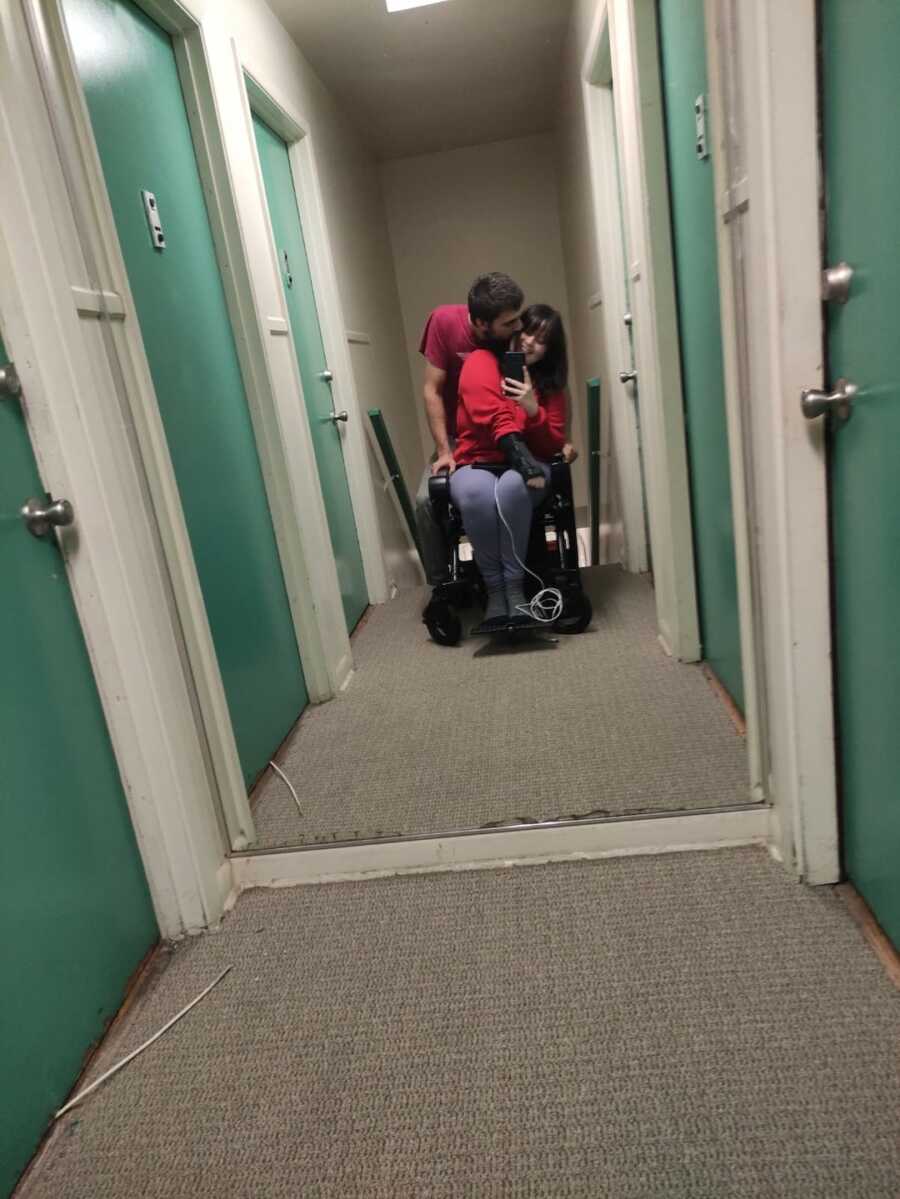
I was told in my extreme distress that what I was experiencing was, in fact, just a virus. That my POT’s syndrome was ‘being messed with,’ by a strange virus that would, ‘surely be gone within the week.’ I was sent home with warped vision, fingers that wouldn’t close all the way, and the encouragement to, ‘keep up the commitment to my dietary habits and exercise!’ I distinctly recall that doctor looking at the scale and the inevitable couple of pounds that came with his wildly high dose steroid prescription, telling me if I stayed on course and didn’t gain any more weight, ‘I wouldn’t end up fat and disabled.’
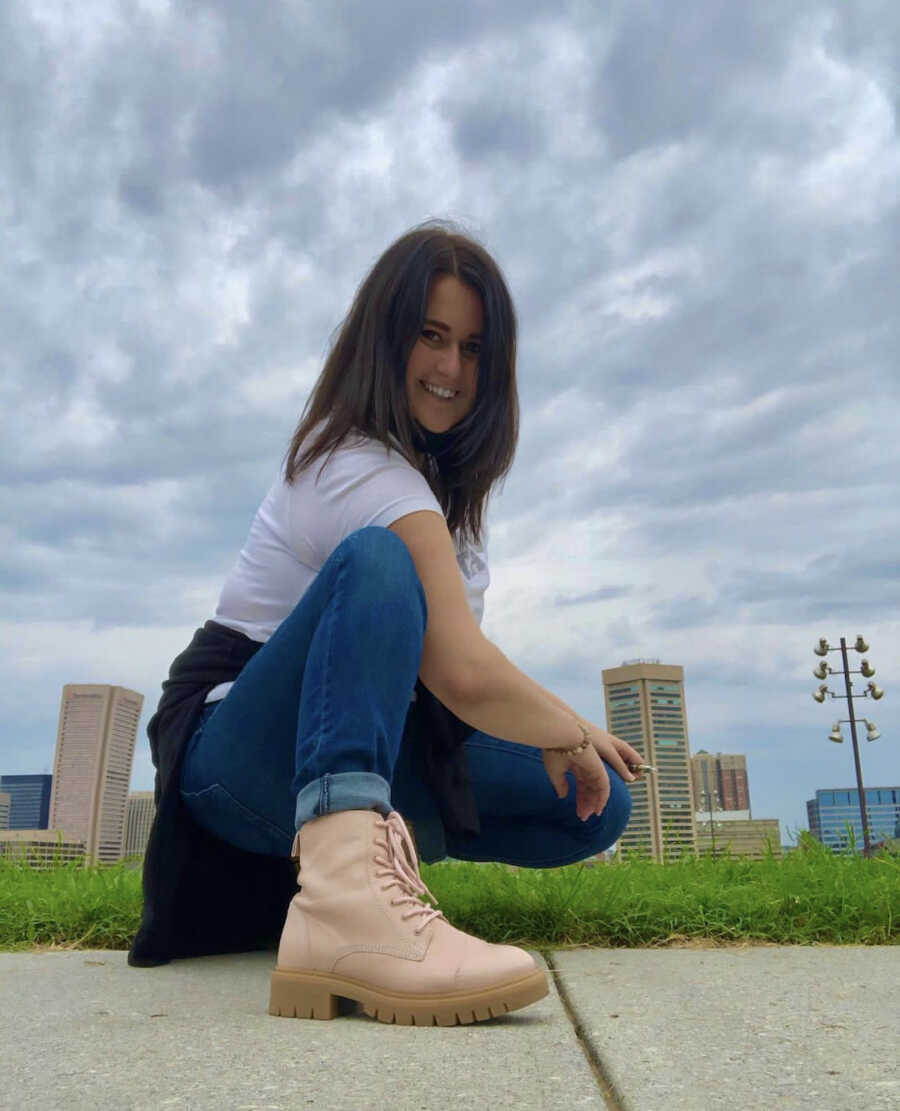
Medical Mistreatment
What I can now identify as rampant fat phobia and ableism that was sprinkled throughout my diagnostic process, and the medical field in general, began to permeate my pores and alter my ways of thinking. Not to mention, when the ‘virus’ wouldn’t go away, I was put on an endless barrage of medications, both established and experimental, with side effects I was too young to research but will now spend many years attempting to fully reverse. If that even turns out to be possible. Let me be clear: I am WILDLY pro modern medicine and this is NOT an anti-hospital or doctor rant – this is a cry for reform of a safe space.
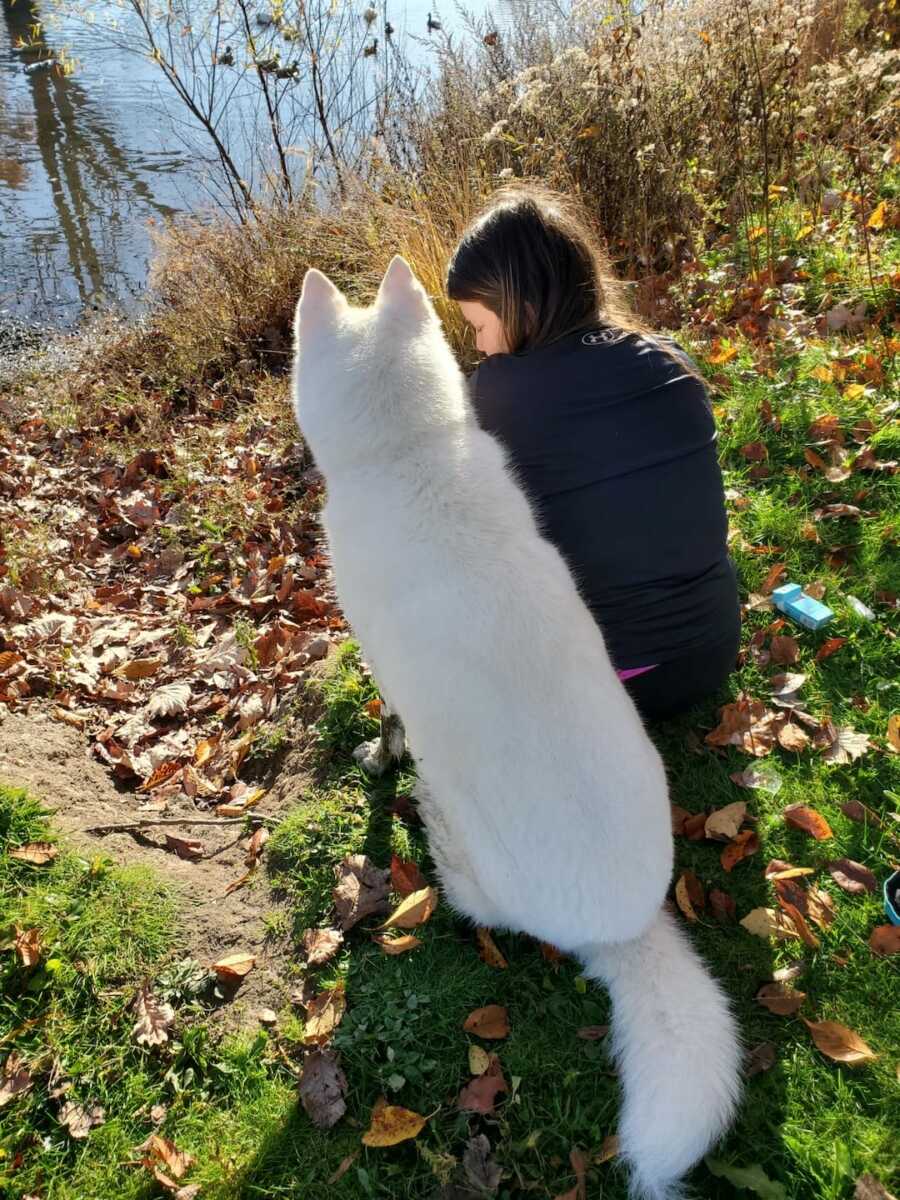
I would have episodes of ten out of ten pain during the time before we could find my diagnoses, when we were calling what I had ‘POTs and some weird virus.’ I would go to the ER when the episodes would get out of hand, clutching my diagnosis of ‘POTs and some connective tissue virus,’ thinking The Magic Doctor would swoop in and give me fluids, answers, and respect. I quickly learned this was a fairytale. Being undiagnosed in an ER is like bleeding in a shark tank, which is deeply unfortunate as the undiagnosed demographic of the chronically ill ARE who needs to feel safety in the ER most. It’s so hard to tell whether something is or isn’t emergent when you’re not sure what your diagnosis actually is.

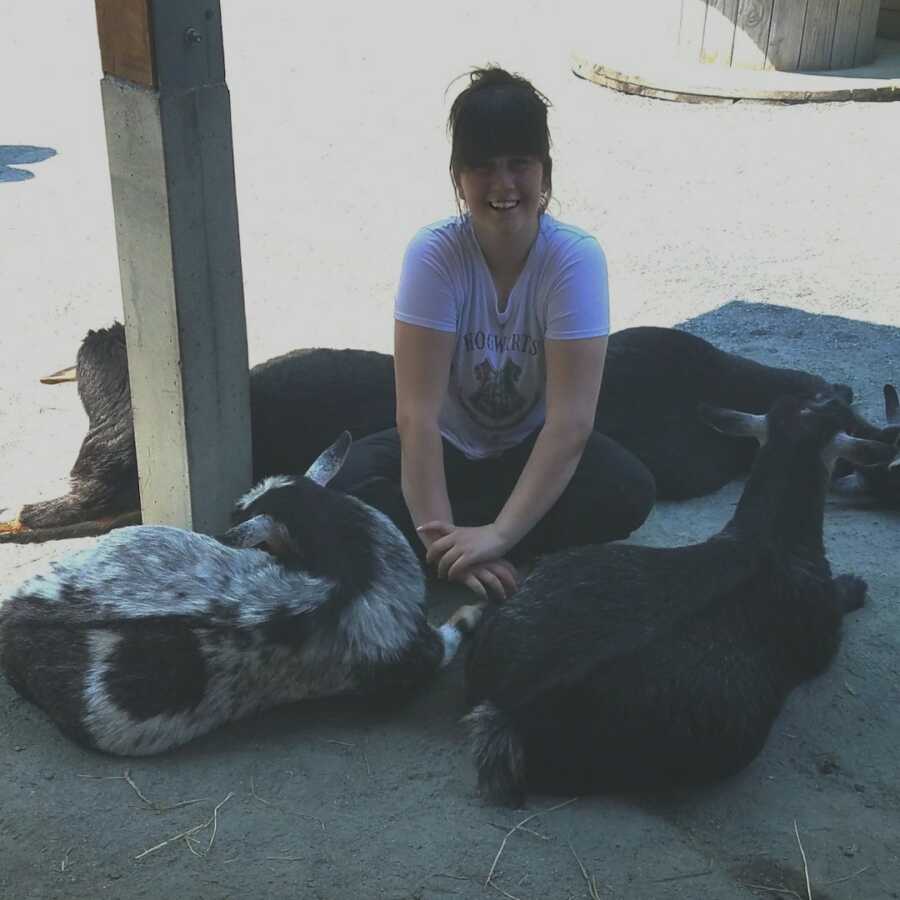
That being said, as an undiagnosed person, quotes I have directly heard in the emergency room include, ‘She’s too fat for this to be anorexia,’ (it was anorexia), ‘She is so dramatic she does NOT have lupus’ (spoiler: it was lupus), and my personal favorite, ‘There’s nothing to be done for women like this. You’ve exhausted modern medicine, are you happy? There IS no answer. You got what you wanted. Painkillers and a vacation.’ Even if I had been in the hospital as an addict seeking drugs, which I absolutely was not, addiction is an emergent illness too that should not be shamed, but treated.
As a side note, ‘Drug seeker,’ is a dangerous and lazy term that perpetuates stereotypes that stop drug addicts from receiving the love and respect, and most importantly treatment they deserve. It also makes it harder for chronically ill people to safely tell ER docs how bad their pain is – but that’s all just one version of the same experience chronically ill people have over and over. Doctors who have refused me treatments I ended up needing over the years, all ended up being easily traced back to their personal bigotry and phobias toward who they saw me as.
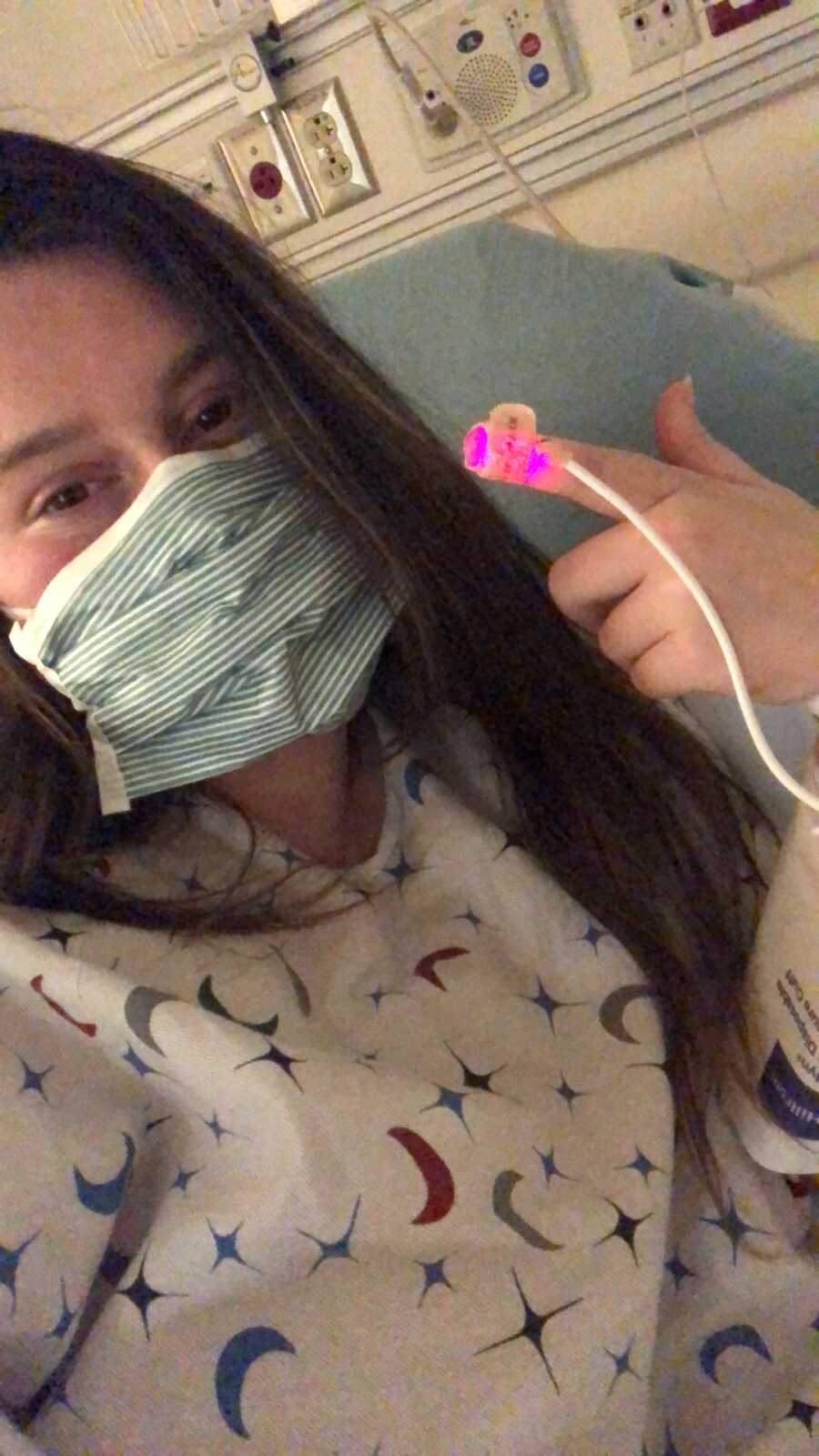
ER’s, which are designed and equipped for emergencies, sometimes get frustrated when they can’t find out if what’s wrong with you is an emergency either. The mistake often made here is taking this frustration out on patients by throwing out terms like ‘drug seeker,’ ‘drama queen,’ and ‘incurable,’ when those terms are nowhere near warranted. The problem here is that instead of being met with compassion, in my experience in the undiagnosed chronically ill patient’s role, we end up in the unique position of seeing this system at its worst. The racism, fatphobia, gaslighting, sexism, homophobia, transphobia, xenophobia, and antisemitism, that transpires on any given day in what is meant to be a safe place for a human in an emergency was a shock to what I thought I knew about the world.
I recognize I am saying this as a straight size-passing, white, woman in a heterosexual relationship and in a position of privilege. I can assure you with my whole heart, my worst and most traumatic experiences were still privileged ones compared to voices more marginalized than my own. But I do say that as a woman who was forced to crawl back and forth between the bathroom and her bed with three broken ribs and legs that kept giving out from underneath her during a hospital stay because the nurse unhooked my call button. She said I was ‘overusing it,’ and ‘could get to the bathroom myself.’ Quite literally, unhooked the call button. I broke another rib because she wouldn’t come help me. But I’m not here to write about every atrocity I’ve experienced as a singular chronically ill person, I’m here to write about the patterns that are causing so many of us to have this wildly isolating and very common ‘rare,’ experience.
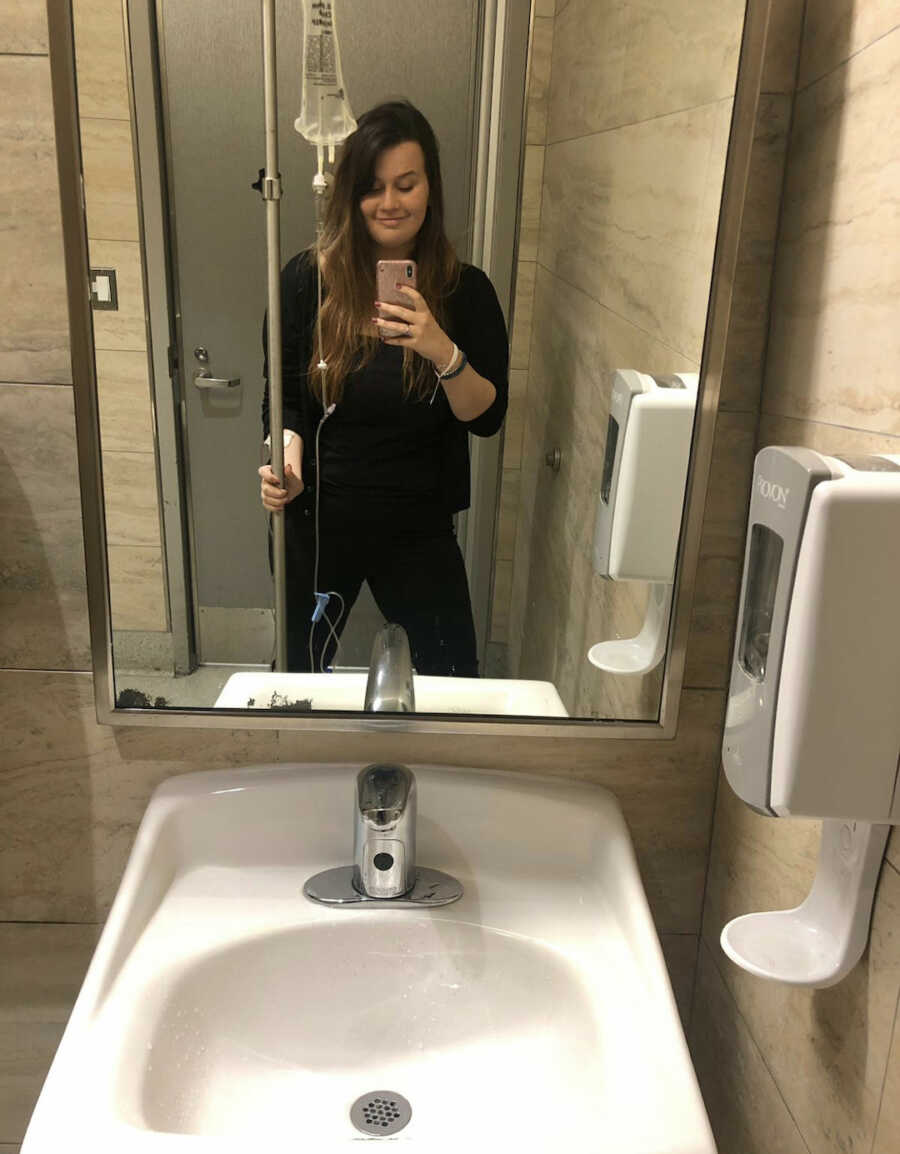
As it turns out, I did a lot of my own research and demanded testing from a doctor who listened to me about every suspicion I had. I was right about all of them. Lupus, Fibromyalgia, POTs, WPW, Sjorgrens, Raynauds, Costochondritis, Celiac, Endometriosis, among others. Over the next ten years I was diagnosed with ten more chronic illnesses and disabilities – and counted every diagnosis as an answer and a blessing (I’m currently in the diagnostic process for Ehlers Danlos as well).
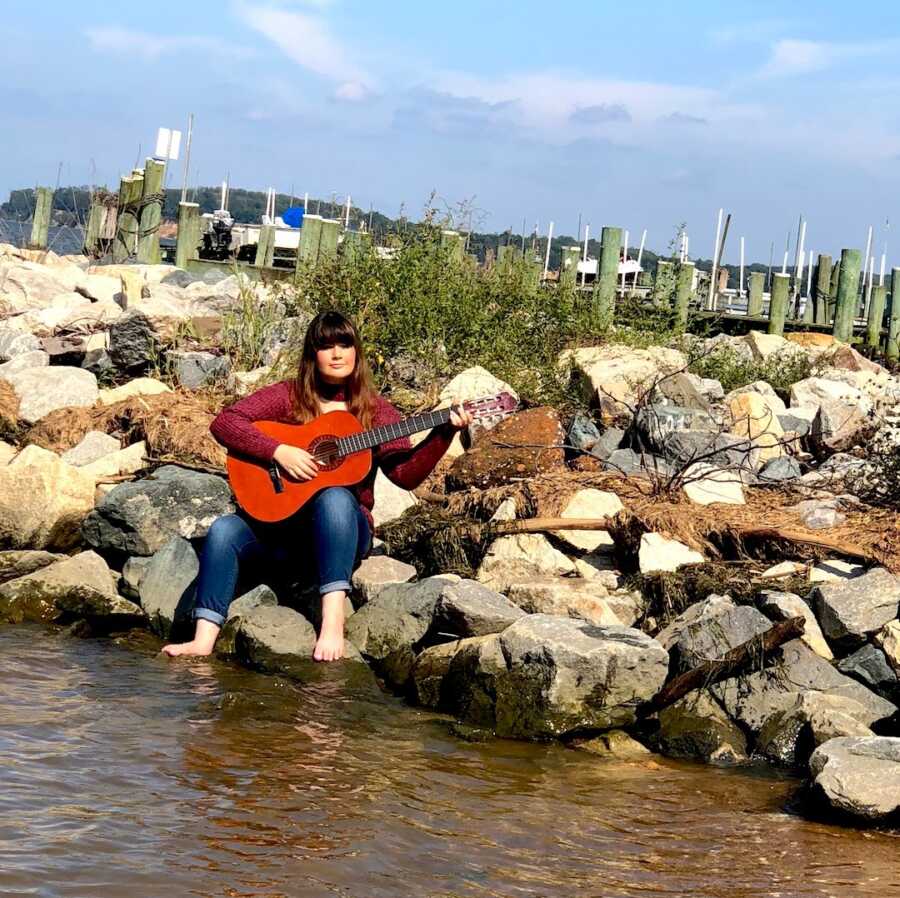
I found peace and validation in validating others on social media, by fully diving into my identity as a disabled and chronically ill person. I began to make content as the voice you’re reading here: the Carrie Bradshaw-wannabe turned chronically ill wheelchair dweller with a passion for healing the system that was created to heal us but designed to hurt us. I started creating content about not only the realities and (ridiculousness), of living with the illnesses themselves, but also the realities of the medical system. In a way I try to keep it light and comedic while pointing out to patients that they deserve to advocate for themselves, even though they shouldn’t have to.
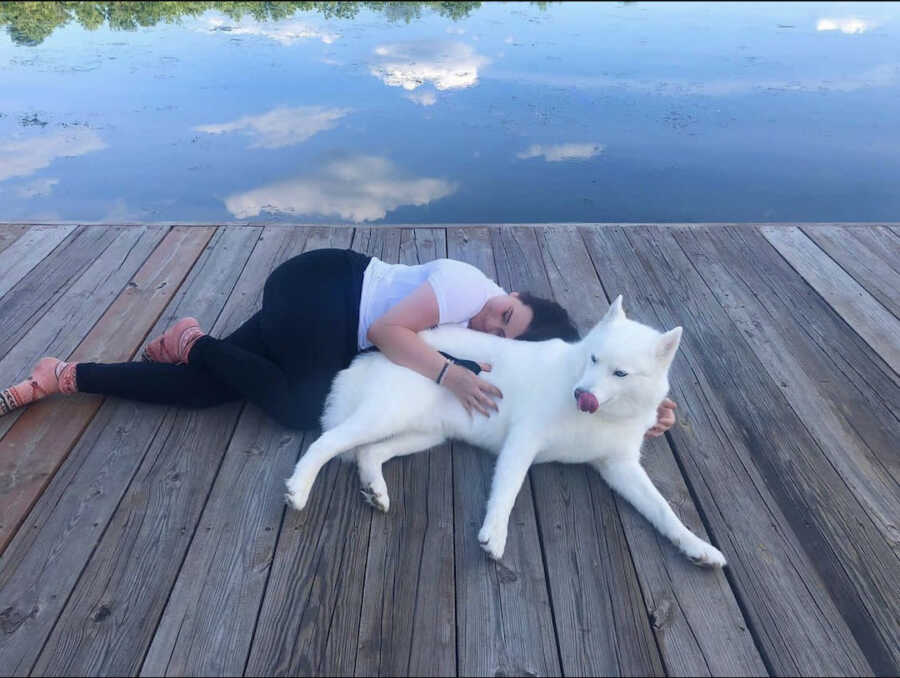
The next thing I knew I had 20,000 followers on TikTok, and more recently a rapidly growing Instagram presence. My account has become a vibrant community of people who were sure they were the only one living the life so many of us are living. Getting to facilitate those conversations in my comments section as well as on live streams, and not being afraid to advocate for what I deserve, for what all of us have always deserved from the medical system and each other as a community, has been deeply healing for me. We WILL change the way patients are treated one day, from the inside out.
Healing From Medical Trauma
Next thing I knew, my illnesses were managed, my tiny corner of my community was thriving, and I still…wasn’t. I thought this was the happy upswing in the story where I start to inspire others but at the top of my metaphorical mountain, but when I got there, I was wiped. I did not feel good. The painful but crucial truth is: my body wasn’t all that needed to heal. Medical trauma is its whole own, brand new beast. And by the time I met it I felt too tired to fight. But I knew it wasn’t over until my nervous system learned how to truly be at peace with all of this too – which isn’t a decision, it’s a long, long process I choose every day and with whatever help accessible to me.
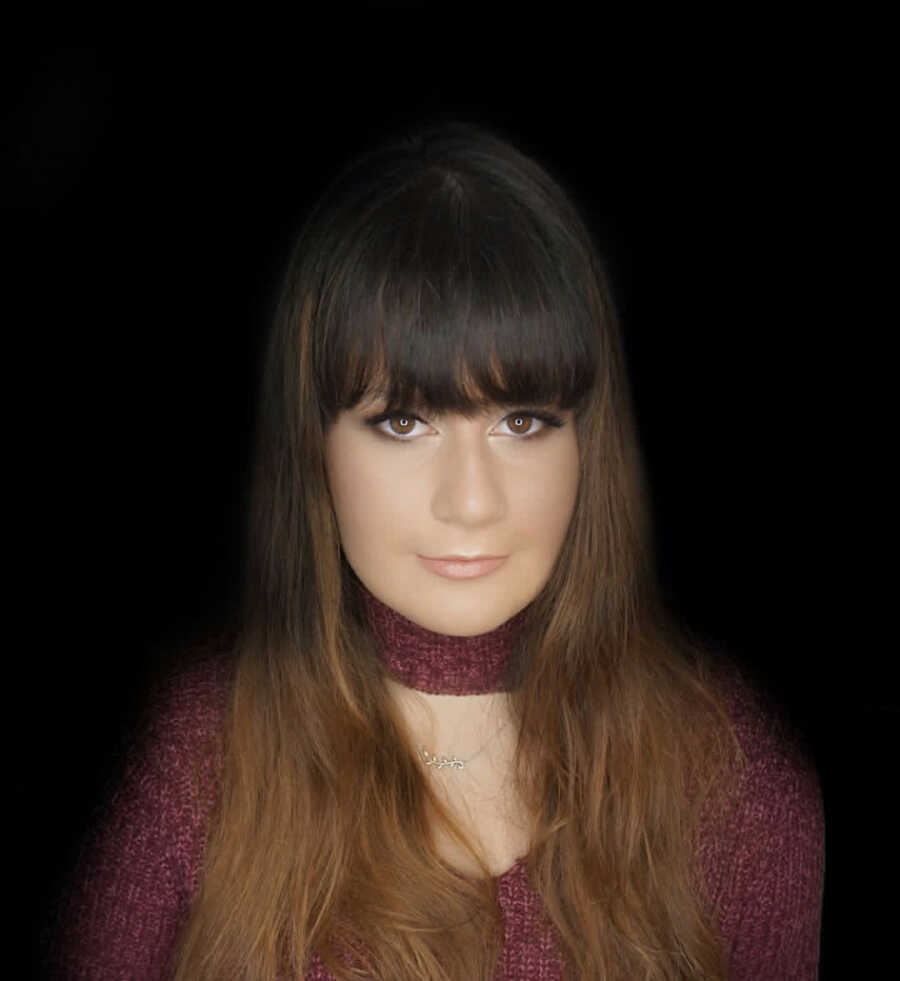
A lot of the reason I wasn’t healing post correct diagnoses with the care I needed was because the need to acknowledge how there was healing necessary from not only the illness itself, but the attempt to survive it. Medical PTSD is extremely real, and this experience changed the way I think – but thanks to therapy and trauma work, it healed it for the way, way better.
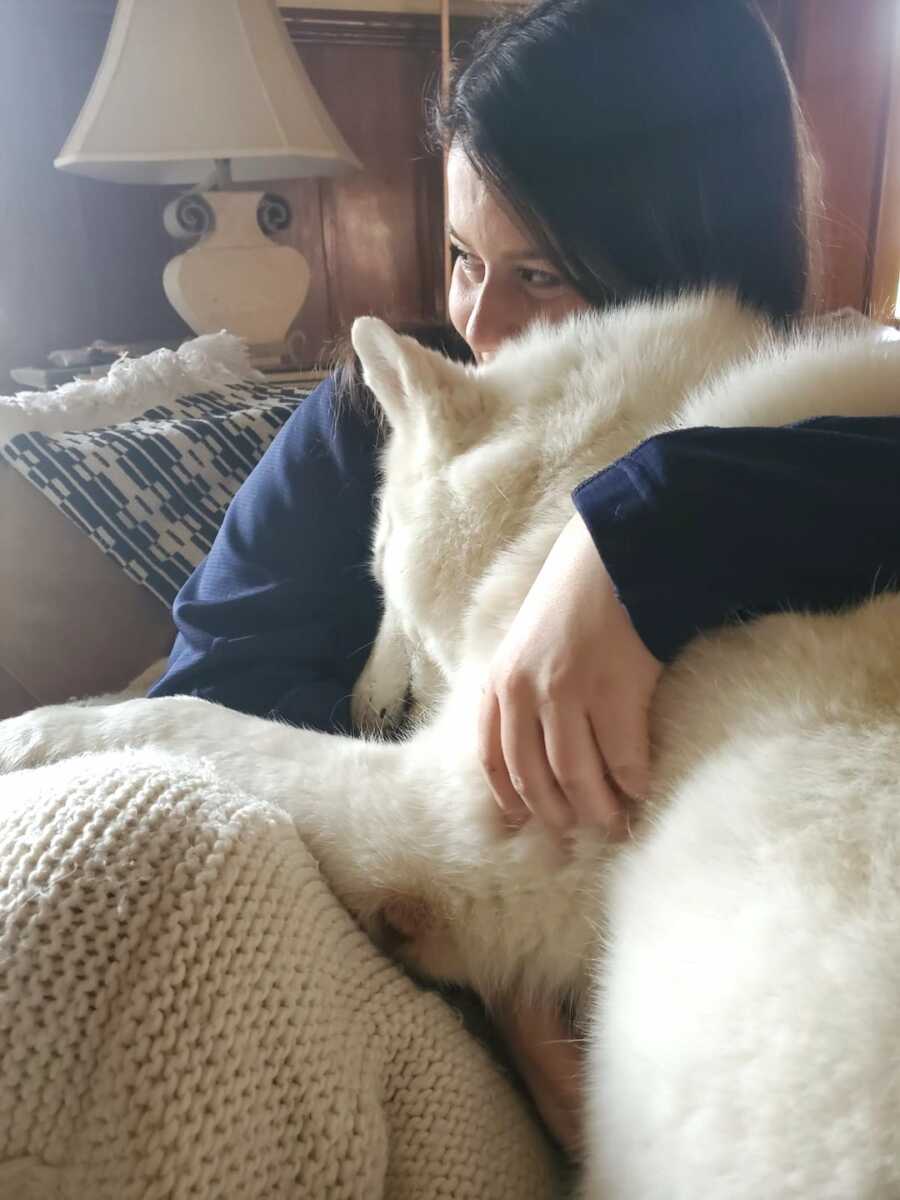
The help I deserved but gaslit MYSELF out of taking was just as damaging as what the doctors did to me (keeping myself out of an ambulatory wheelchair despite it giving me my life back cause I ‘wasn’t a real disabled person,’ in my own eyes, even though I was breaking bones trying to walk, etc.) It was anorexia treatment, therapy, and eventually the genuine unlearning of internalized ableism that led me to where I get to be right now: a proud, ambulatory wheelchair user and soon to be service dog handler who’s been saving up her strength to make some noise about what we as the disabled community, diagnosed or not, deserve.
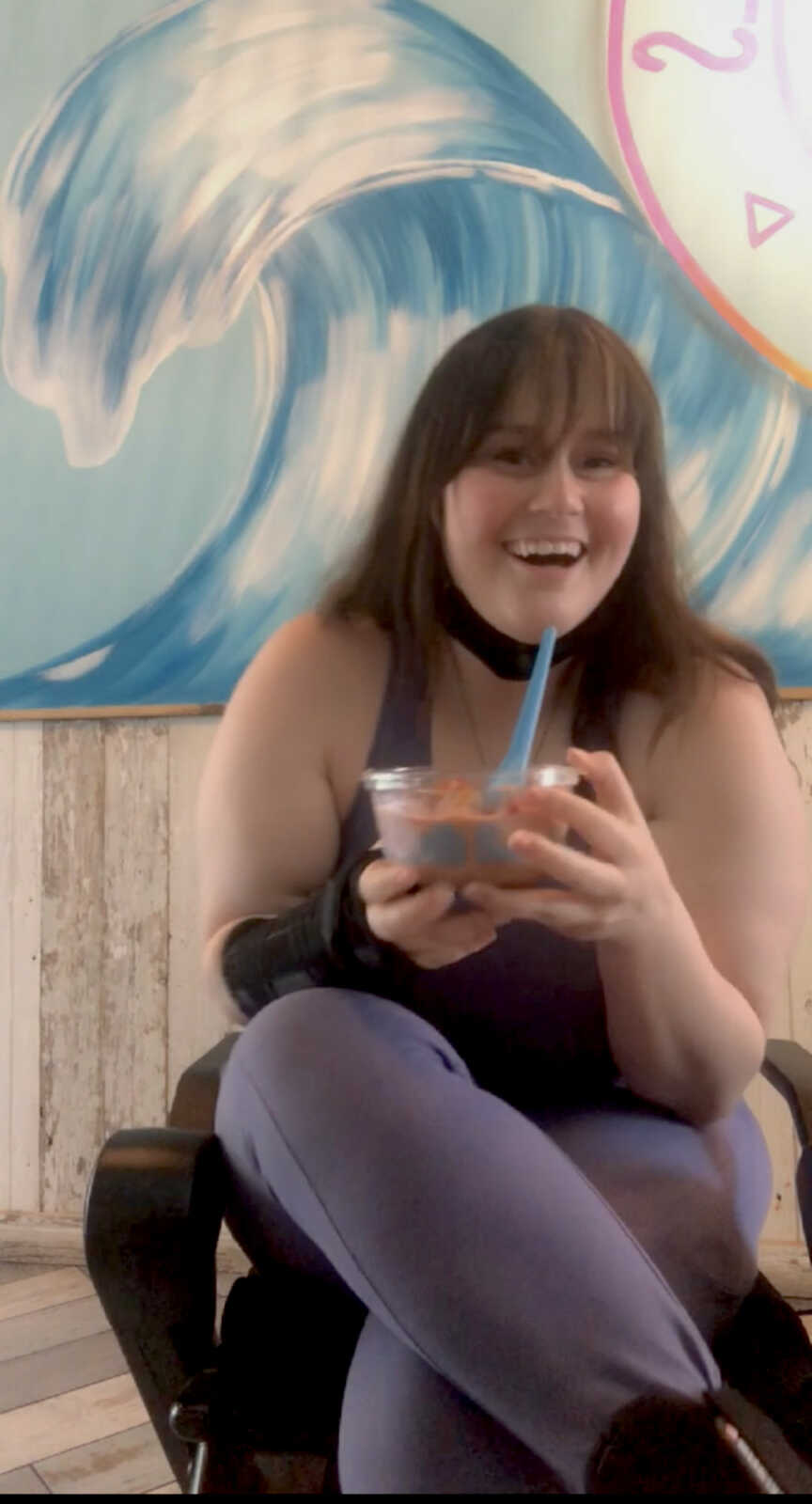
Access to diagnosis is a privilege, and help, respect, and acceptance should not be contingent on that privilege – from medical professionals or our own community. Accepting disabled as a part of my identity – with all of the hell and all of the help that could come with it – is the best thing I ever did for my own health. The me you see with the mobility aids is far healthier and herself than the masking, working 12 hours a day me who had ‘just POTs and a virus or something.’ Listen to your inner voice, and seek the help you believe you need. You’re less alone than you feel, and you’re doing better than you think.”

This story was submitted to Love What Matters by Leah Asher of Baltimore, Maryland. You can follow her family journey on Instagram and TikTok. Submit your own story here and be sure to subscribe to our free email newsletter for our best stories, and YouTube for our best videos.
Read more stories like this:
Do you know someone who could benefit from this story? Please SHARE on Facebook and Instagram to make them aware there is a community of support available.

